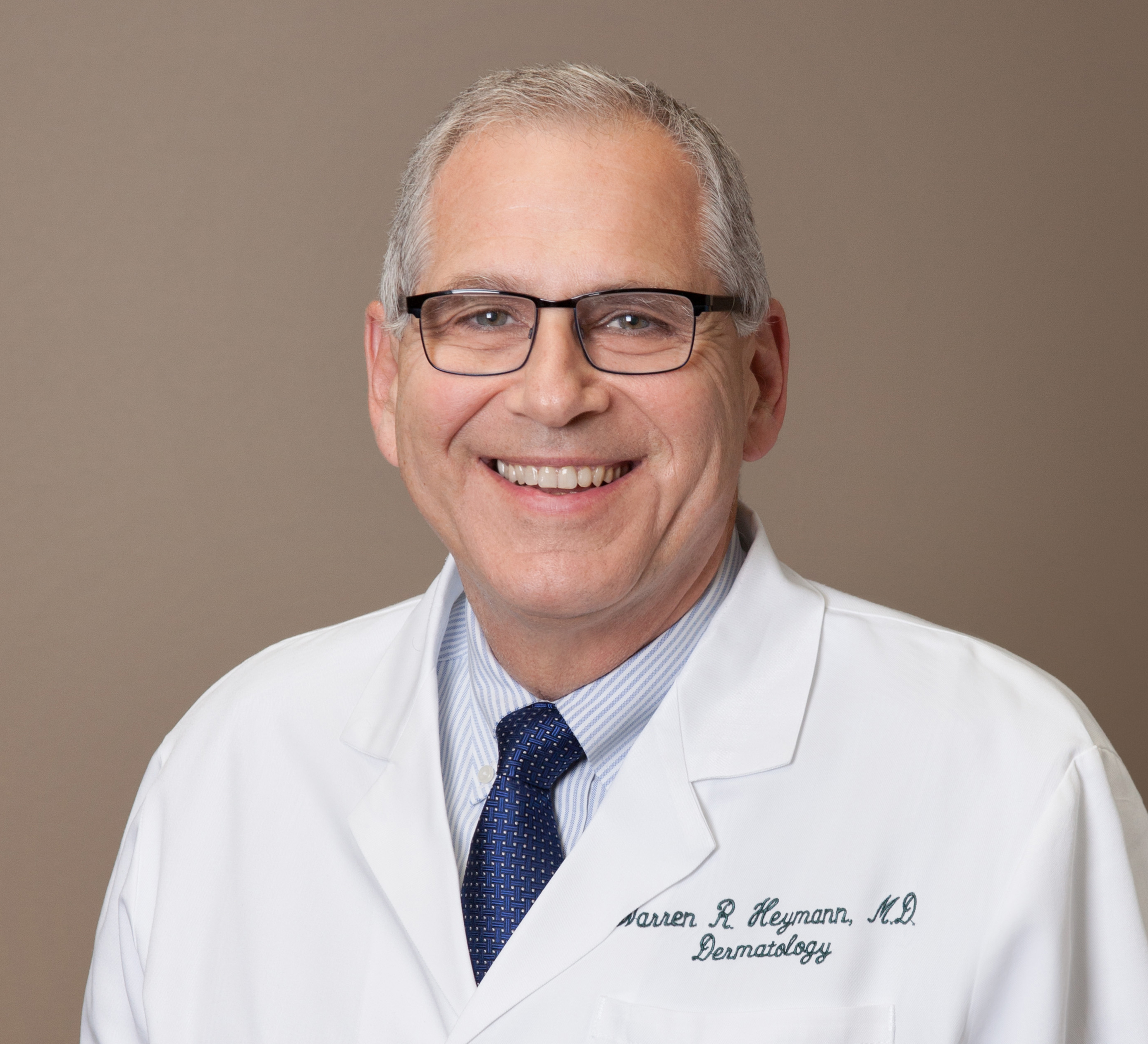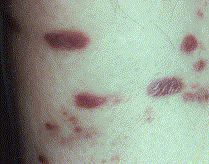5ta forma de Sarcoma de Kaposi
NONEPIDEMIC KAPOSI SARCOMA: THE FIFTH DIMENSION

By Warren R. Heymann, MD
Oct. 16, 2019
Vol. 1, No. 32

For more than a century, since first described in 1872 by Moritz Kaposi* as "idiopathic multiple pigmented sarcoma," dermatologists focused on classical Kaposi sarcoma (KS) — violaceous patches, plaques, and tumors on the lower extremities of elderly men of either Mediterranean or Eastern European (Ashkenazi Jewish) descent. In 1982, as a dermatology resident attending a New York Dermatology Society meeting, I first learned of cases of KS appearing in young men having sex with men (MSM), several of whom also had pneumocystis pneumonia. The profound impact of that presentation was instantly recognizable — within days, we were seeing similar patients who then developed previously unheard of — and at that time, unnamed — entities such as oral hairy leukoplakia or bacillary angiomatosis. This was only weeks after Friedman-Kien et al described 19 cases of KS in MSM with histories of multiple sexually transmitted diseases who also had exposure to both prescription and recreational drugs. (1)
Currently, dermatologists routinely recognize four clinico-epidemiologic forms of KS: 1) classic KS (relatively indolent disease, mostly in elderly men with an increased risk of secondary malignancies); 2) endemic KS (younger population, most commonly in HIV-negative men in East and Central Africa; a lymphadenopathic form without cutaneous involvement is observed in young HIV-negative children in the same region); 3) epidemic KS (HIV-infected MSM in Western countries and HIV-infected heterosexual men and women in sub-Saharan Africa. This form is often accompanied by extensive, disseminated mucocutaneous and visceral lesions, and systemic symptoms of fever, weight loss, and diarrhea); and 4) iatrogenic KS in patients on immunosuppressive medications, typically for organ transplantations, chemotherapy, or rheumatologic disorders. (2,3)
There is a fifth epidemiologic type of KS — the nonepidemic variant. (I assume that this term has taken hold to differentiate it from the HIV-associated epidemic form of KS.)

In 1986, Afrasiabi et al reported 3 MSM with biopsy-proven KS. According to CDC criteria, this classified these men as having AIDS … yet they were HIV-negative. Furthermore, they differed from most patients with AIDS and KS by having normal CD4 counts and a normal CD4:CD8 ratios; these immunologic parameters remained stable for 8 to 24 months of follow-up, without disease progression. (4) In their review of nonepidemic KS, Vangipuram and Tyring note that saliva exchange during sexual activities appears to be the major source of HHV-8 transmission among MSM. (5)
In the largest series of nonepidemic KS, 28 HIV-negative MSM were studied retrospectively by Lanternier et al. The mean age at first signs of KS was 53 years. Clinical presentation resembled classic KS, with limited disease in most patients. No cellular or humoral immunodeficiency was detected. Three patients developed lymphoproliferative disorders (Castleman disease, follicular lymphoma, and Burkitt lymphoma). The authors concluded that this type of KS clinically resembles classic KS but occurs in younger men. Although its prognosis is good, clinicians should be aware of the association with lymphoproliferative diseases, which could affect overall prognosis. (6)
Key questions need to be addressed regarding the pathogenesis of nonepidemic KS. Are there yet undefined predisposing factors causing immunodysregulation in these patients that allows HHV-8 to become pathogenic? Most importantly, are these distinctions important? Do we attack HHV-8, attack HIV, or attack the malignant cells, with the goal to restore immunity?
Treating KS depends upon the type: For epidemic KS, high-activity antiretroviral therapy is the cornerstone of management, thereby raising CD4 counts. For iatrogenic KS, reduction of immunosuppression is warranted. For classic, endemic, and nonepidemic KS, treatment options are much wider; they vary from local excision, cryosurgery, radiation, topical agents (e.g., imiquimod, alitretinoin), intralesional vincristine, or systemic chemotherapy. On May 13, 2019, the FDA designated pomalidomide (a thalidomide derivative with immunomodulatory activity) as a breakthrough therapy for treating KS, although to be clear this status does not confer FDA-approval for treating KS). This was based on the study by Polizzitto et al, in which 22 KS patients were treated with pomalidomide; 15 (68%) were HIV infected, 17 (77%) had advanced disease, and 19 (86%) had previous KS therapy excluding antiretroviral therapy. Sixteen patients responded (73%): 9 of 15 HIV-infected patients (60%) and all 7 HIV-uninfected patients (100%). Median time to response was 4 weeks (range, 4 to 36 weeks). The authors concluded that pomalidomide is well tolerated and effective in KS regardless of HIV status. (7)
It is fitting that since there was more than one iteration of Moritz Kaposi himself, that the sarcoma bearing his name has several variants. Dermatologists need to classify KS correctly, in order to prognosticate soundly and treat the disease appropriately.
*Moritz Kaposi was born in 1837, named Moritz Kohn. He studied and practiced at the University of Vienna under the world-renowned dermatologist, Ferdinand Ritter von Hebra. He married von Hebra's daughter, Martha, in 1869, leaving Judaism to join the Catholic Church. In 1871, he changed his name to Kaposi, after his Austro-Hungarian hometown of Kaposvár. Upon von Hebra's death in 1880, he assumed the directorship of the Dermatology Department at the University of Vienna
Point to remember: It is time to recognize a fifth clinic-epidemiological form of Kaposi sarcoma — the nonepidemic form mostly observed in HIV-negative MSM, which seems to have a good prognosis. As in classic KS, patients with nonepidemic KS need to be followed because of the risk of second malignancies (notably lymphoproliferative).
Our expert's viewpoint
Scott A. Norton, MD, MPH, MSc
Chief of Dermatology, Children's National Health System
"The world can be divided into two types of people: those who divide the world into two types and those who don't."
Attributed to Robert Benchley, Vanity Fair [the magazine, not Thackeray's novel], 1920
Benchley's aphorism may be true, but dermatologists are rarely content with mere bifurcation; we have a penchant for taking a condition and subjecting it to being drawn-and-quartered.
Such was the state of our understanding of Kaposi sarcoma (KS) and its four clinico-epidemiologic forms for the past 35-40 years. Dr Heymann's essay asks us to increase the number of recognized forms of KS from 4 to 5. As a former field biologist who is comfortable with the nuances of identification, nomenclature, taxonomy, and phylogeny, I read the essay and the reviewed the background literature with great interest. Is there a sound argument for designating a fifth form of KS? Is the fifth form both biologically plausible and clinically meaningful?
I believe the answers are Yes and Yes. In other words, there is both biologic plausibility and clinical relevance to recognizing a fifth form of KS.
Of course, all forms of KS entail infection with HHV-8 followed by the appearance of clinical lesions that have characteristic histologic and immunologic features. But the clinico-epidemiological context varies greatly among the five forms. In the past, I have puzzled over particular MSM patients with confirmed cases of KS … yet these specific individuals were HIV-negative, had healthy CD4 counts, and never had an opportunistic disease or other condition typically associated with HIV infection.
This fifth form challenges our understanding of KS and it challenges our thoughts on treating patients with KS. After all, we are accustomed to administering HAART to MSM patients with KS in order to boost their immune systems. But to our knowledge the immune systems of patients with nonepidemic KS do not need a boost. Therefore, this category, nonepidemic KS (arising in young, ostensibly healthy men), teases us with its "defiance of the rules." One way to stop the teasing is to determine what exactly is happening when KS appears in young, apparently healthy, HIV-negative MSM. What can the increasing number of cases of this clinico-epidemiologic form teach us? What can it teach us that will help people with this form — or any form — of KS? Can it help us manage individual patients with advanced HIV disease? Can it help us manage entire large populations with HIV?
Sun Tzu said one must know the names of one's enemies. In this case, we can add nonepidemic Kaposi sarcoma to our list of enemies.
Friedman-Kien AE, Laubenstein LJ, Rubinstein, Buimovici-Klein E, et al. Disseminated Kaposi's sarcoma in homosexual men. Ann Intern Med 1982; 96 (6 Pt 1): 693-700.
Hinbojosa T, Lewis DJ, Liu M, Garza G, et al. Nonepidemic Kaposi sarcoma: A recently proposed category. JAAD Case Rep 2017; 3: 441-443.
Bishop BN, Lynch DT. Cancer, Kaposi sarcoma. Stat Pearls [Internet]. Treasure Island 9FL): Stat Pearls Publishing 2019 Jan.
Afrasiabi AR, Mitsuyasu RT, Nishanian P, Schwartz K, Fahey JL. Characterization of a distinct subgroup of high-risk persons with Kaposi's sarcoma and good prognosis who present with normal T4 cell number and T4:T8 ration and negative HTLV-III/LAV serologic test results. Am J Med 1986; 81: 969-973.
Vangipuram R, Tyring SK. Epidemiology of Kaposi sarcoma: Review and description of the nonepidemic variant. Int J Dermatol 2019; 58: 538-542.
Lanternier F, Lebbé C, Schartz N, Farhi D, et al. Kaposi's sarcoma in HIV-negative men having sex with men. AIDS 2008; 22: 1163-1168.
Polizzotto MN, Uldrick TS, Wywill KM, Aleman K, et al. Pomalidomide for symptomatic Kaposi's sarcoma in people with and without HIV infection: A phase I/II study. J Clin Oncol. 2016; 34: 4125-4131.
Hundeiker M. Moriz Kaposi. In Löser C, Plewig G, Burgdorf WHC [eds.] Pantheon of Dermatology. Springer-Verlag, Berlin, 2013, pp. 571-581.
All content found on Dermatology World Insights and Inquiries, including: text, images, video, audio, or other formats, were created for informational purposes only. The content represents the opinions of the authors and should not be interpreted as the official AAD position on any topic addressed. It is not intended to be a substitute for professional medical advice, diagnosis, or treatment.
Skin Care Physicians of Costa Rica
Clinica Victoria en San Pedro: 4000-1054
Momentum Escazu: 2101-9574
Please excuse the shortness of this message, as it has been sent from
a mobile device.
posted by dermatica at
October 16, 2019
![]()
![]()

0 Comments:
Post a Comment
Subscribe to Post Comments [Atom]
<< Home